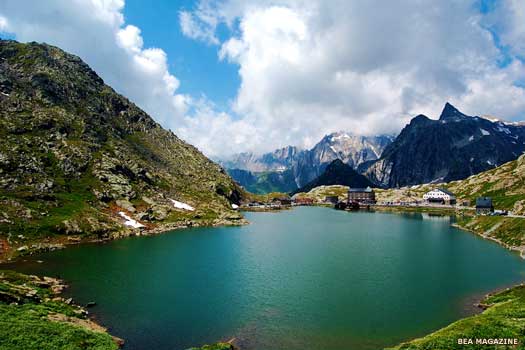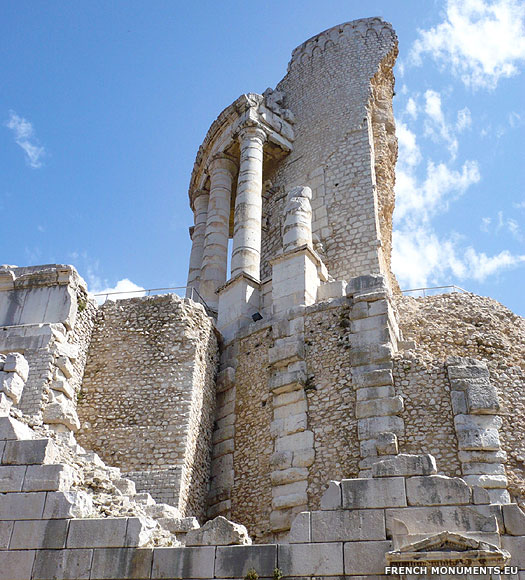 |
|
| (Information by Peter Kessler and Edward Dawson, with additional information from Research into the Physical History of Mankind, James Cowles Prichard, from Roman History, Cassius Dio, from Les peuples préromains du Sud-Est de la Gaule: Étude de géographie historique, Guy Barruol (De Boccard, 1999), and from External Links: The Works of Julius Caesar: Gallic Wars, and Defeat of the Vocates and Tarusates, J Rickard, and Geography, Strabo (H C Hamilton & W Falconer, London, 1903, Perseus Online Edition), and L'Arbre Celtique (The Celtic Tree, in French), and Historisches Lexikon der Schweiz or Dictionnaire Historique de la Suisse or Dizionario Storico dell Svizzera (in German, French, and Italian respectively).) |
|
| 56 BC |
Following his successful campaign against the Belgae in the previous year, Caesar heads for Italy. He sends Servius Galba ahead with the Twelfth Legion and part of the cavalry to secure the way. The pass through the Alps has been dominated by the Nantuates, Seduni, and Veragri tribes, making the route a dangerous one for Roman merchants, and now is the time to end that danger.  The origins of the Euganei, Ligurians, Raeti, Veneti, and Vindelici are confused and unclear, but in the last half of the first millennium BC they were gradually being Celticised or were combining multiple influences to create hybrid tribes (click or tap on map to view full sized) The origins of the Euganei, Ligurians, Raeti, Veneti, and Vindelici are confused and unclear, but in the last half of the first millennium BC they were gradually being Celticised or were combining multiple influences to create hybrid tribes (click or tap on map to view full sized) |
Galba conducts a few successful battles and storms several of their forts, until the tribes send embassies and hostages, and peace is concluded. Galba stations two cohorts amongst the Nantuates, and sets up camp with the legion's remaining cohorts in the village of Octodurus, which belongs to the Veragri. The village is situated in a valley with a small plain, and is bounded on all sides by very high mountains. Galba takes the unoccupied half of the village as winter quarters for his troops, and fortifies it with a rampart and ditch. Several days later, the Veragri tribe has vanished from the village and has assembled in the mountains overlooking the valley with a very large force of Nantuates and Seduni. The legion, which is reduced in size after detachments have been made, appears vulnerable to the Celts, who are convinced that the Romans want to conquer all of Gaul. The Romans decide to defend their position, and are hard-pressed by the superior numbers attacking them, perhaps thirty thousand in all. The six hour battle ends when the exhausted Romans make a last-ditch sally which takes the Celts by surprise and inflicts heavy casualties on them, forcing them to withdraw.  The region around the Great St Bernard's Pass was a perfect mix of fertile plains and protective high mountains for small but aggressive Celtic tribes in the four centuries or so between their settlement of the area and domination by Rome The region around the Great St Bernard's Pass was a perfect mix of fertile plains and protective high mountains for small but aggressive Celtic tribes in the four centuries or so between their settlement of the area and domination by Rome |
|
| Having survived the onslaught, the Romans withdraw in good order, heading westwards into the territory of the Allobroges where they settle into safer winter quarters. |
|
| 25 - 15 BC |
Augustus determines that the Alpine tribes need to be pacified in order to end their warlike behaviour, alternately attacking or extracting money from Romans who pass through the region, even when they have armies in tow. He wages a steady, determined campaign against them during the Alpine Wars, and in a period of ten years he 'pacifies the Alps all the way from the Adriatic to the Tyrrhenian seas' (written by Augustus himself). |
| 14 BC |
Emperor Augustus creates the province of Alpes Maritimae (the maritime, or seaward, Alps). It has its capital at Cemenelum (modern Nice, although this is switched in 297 to Civitas Ebrodunensium, modern Embrun). The history of the Alpine region's population of Celts and Celto-Ligurians is now tied to that of the empire.  The Tropaeum Alpium ('Trophy of the Alps') stands majestically in the commune of La Turbie on the French Riviera, overlooking the principality of Monaco, and marking the final victory over the Alpine tribes by Augustus The Tropaeum Alpium ('Trophy of the Alps') stands majestically in the commune of La Turbie on the French Riviera, overlooking the principality of Monaco, and marking the final victory over the Alpine tribes by Augustus |
 |
|
 In general terms, the Romans coined the name 'Gaul' to describe the Celtic tribes of what is now central, northern, and eastern France. The Gauls were divided from the Belgae to the north by the Marne and the Seine, and from the Aquitani to the south by the River Garonne, while also extending into Switzerland, northern Italy, and along the Danube (see feature link for a discussion of the origins of the Celtic name).
In general terms, the Romans coined the name 'Gaul' to describe the Celtic tribes of what is now central, northern, and eastern France. The Gauls were divided from the Belgae to the north by the Marne and the Seine, and from the Aquitani to the south by the River Garonne, while also extending into Switzerland, northern Italy, and along the Danube (see feature link for a discussion of the origins of the Celtic name).  By the middle of the first century BC, there existed a cluster of smaller tribes in the Alpine region of western Switzerland and the French/Italian border (see map link for all tribal locations). This included the Nantuates, who were located along the upper reaches of the Rhone, around Massongex, and around Lake Geneva (Lac Leman) in today's Canton Valais. The Swiss Historical Lexicon has them living between Lac Leman (Geneva) and the city of St Maurice, to the south-east of Lac Leman. They were neighboured to the north by the Helvetii, to the east by the Seduni and the mysterious Acitavones, to the south by the Veragri, and to the west by the Allobroges and Ambarri. Also called the Nantuatae (and Aetuatae), the difference is not actually in their name, but in the plural ending added onto it. The Nantuates name appears to derive from a word for valley. The proto-Celtic wordlist has *nanto, meaning 'valley', and modern Welsh has 'nant' [nentydd, f.] - (n.), meaning 'brook; gorge, ravine'. The sense seems to be of a mountain valley. After this is what at first glance appears to be the Latin suffix, '-atus' (the modern '-ate'), but that is probably wrong. An intriguing possibility is a word for 'reclaim' or 'reacquire'. The proto-Celtic word list has *tu-ati- (Welsh), [*dī-ati (Brythonic.) plus '-ande-so'], meaning 'reclaim' (?), so they could have been the 'people of the reclaimed valley', perhaps? Switzerland was part of the early Celtic homeland so, theoretically speaking, was this a once-populated area which was being reclaimed after a period of abandonment, or perhaps Celto-Ligurian influence? Caesar noted the tribe's location in his Gallic Wars, close to today's western Swiss border with France. The village of Morgins in the canton of Valais in southern Switzerland claims to have been a Nantuates border region with the Allobroges. The town's name is said to originate from a Celtic word for border, something which is probably based on the proto-Celtic *mrogi-, meaning 'border'. Around ten or eleven kilometres to the south-west is the French town of Morzine, a very similar name which probably has the same origins. The intervening le Pas de Morgins is still the only road to link the French and Swiss resorts of the Portes du Soleil. Strabo calls the tribe the Aetuatae, but he also placed them in the valley of the Rhine.
By the middle of the first century BC, there existed a cluster of smaller tribes in the Alpine region of western Switzerland and the French/Italian border (see map link for all tribal locations). This included the Nantuates, who were located along the upper reaches of the Rhone, around Massongex, and around Lake Geneva (Lac Leman) in today's Canton Valais. The Swiss Historical Lexicon has them living between Lac Leman (Geneva) and the city of St Maurice, to the south-east of Lac Leman. They were neighboured to the north by the Helvetii, to the east by the Seduni and the mysterious Acitavones, to the south by the Veragri, and to the west by the Allobroges and Ambarri. Also called the Nantuatae (and Aetuatae), the difference is not actually in their name, but in the plural ending added onto it. The Nantuates name appears to derive from a word for valley. The proto-Celtic wordlist has *nanto, meaning 'valley', and modern Welsh has 'nant' [nentydd, f.] - (n.), meaning 'brook; gorge, ravine'. The sense seems to be of a mountain valley. After this is what at first glance appears to be the Latin suffix, '-atus' (the modern '-ate'), but that is probably wrong. An intriguing possibility is a word for 'reclaim' or 'reacquire'. The proto-Celtic word list has *tu-ati- (Welsh), [*dī-ati (Brythonic.) plus '-ande-so'], meaning 'reclaim' (?), so they could have been the 'people of the reclaimed valley', perhaps? Switzerland was part of the early Celtic homeland so, theoretically speaking, was this a once-populated area which was being reclaimed after a period of abandonment, or perhaps Celto-Ligurian influence? Caesar noted the tribe's location in his Gallic Wars, close to today's western Swiss border with France. The village of Morgins in the canton of Valais in southern Switzerland claims to have been a Nantuates border region with the Allobroges. The town's name is said to originate from a Celtic word for border, something which is probably based on the proto-Celtic *mrogi-, meaning 'border'. Around ten or eleven kilometres to the south-west is the French town of Morzine, a very similar name which probably has the same origins. The intervening le Pas de Morgins is still the only road to link the French and Swiss resorts of the Portes du Soleil. Strabo calls the tribe the Aetuatae, but he also placed them in the valley of the Rhine.
 The origins of the Euganei, Ligurians, Raeti, Veneti, and Vindelici are confused and unclear, but in the last half of the first millennium BC they were gradually being Celticised or were combining multiple influences to create hybrid tribes (click or tap on map to view full sized)
The origins of the Euganei, Ligurians, Raeti, Veneti, and Vindelici are confused and unclear, but in the last half of the first millennium BC they were gradually being Celticised or were combining multiple influences to create hybrid tribes (click or tap on map to view full sized) The region around the Great St Bernard's Pass was a perfect mix of fertile plains and protective high mountains for small but aggressive Celtic tribes in the four centuries or so between their settlement of the area and domination by Rome
The region around the Great St Bernard's Pass was a perfect mix of fertile plains and protective high mountains for small but aggressive Celtic tribes in the four centuries or so between their settlement of the area and domination by Rome The Tropaeum Alpium ('Trophy of the Alps') stands majestically in the commune of La Turbie on the French Riviera, overlooking the principality of Monaco, and marking the final victory over the Alpine tribes by Augustus
The Tropaeum Alpium ('Trophy of the Alps') stands majestically in the commune of La Turbie on the French Riviera, overlooking the principality of Monaco, and marking the final victory over the Alpine tribes by Augustus